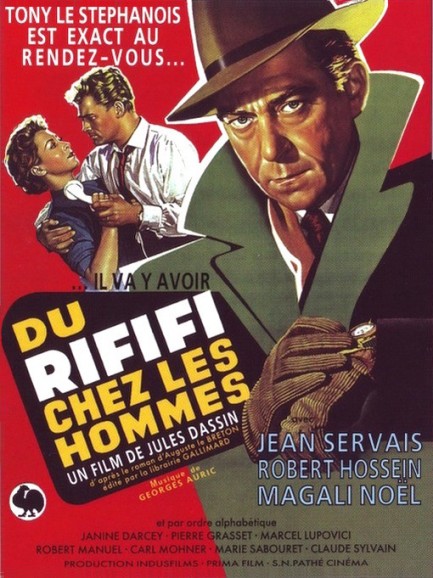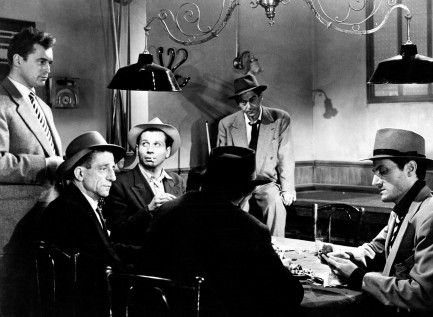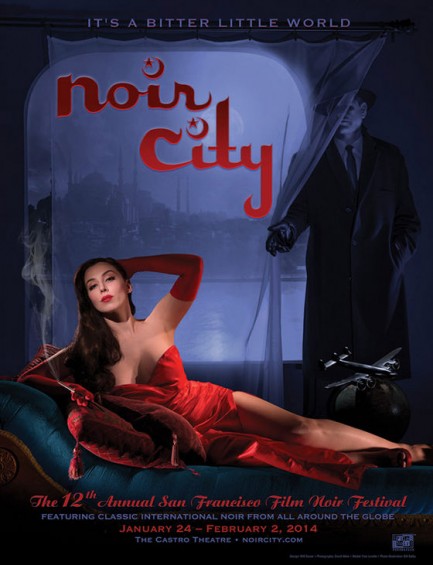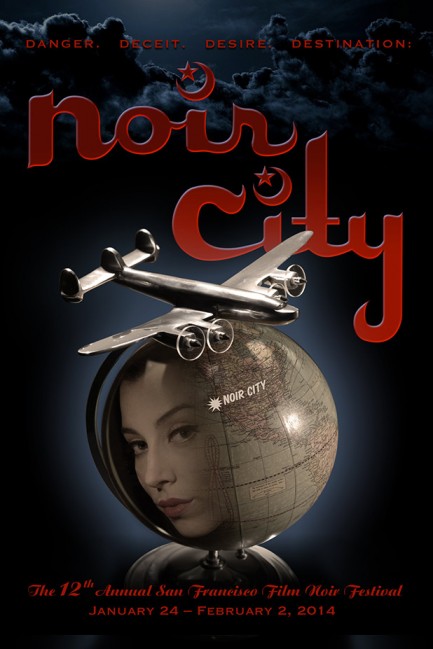 C'est nous qui d'mande du Rififi. 
Tonight the Noir City Film Festival screens Jules Dassin's classic crime drama Du rififi chez les homes, aka Rififi for the second time in three years. It's appropriate, though, since Dassin was the noir master behind Night and the City, Thieves' Highway, The Naked City, and Brute Force. Based on Auguste Le Breton's novel, Rifiifi came in 1955 after Dassin's work had been absent from Hollywood screens for five years—a break brought about due to his blacklisting by the anti commie crowd. Dassin made Rififi in France and reminded Hollywood exactly what they had lost.
We first meet the character Tony le Stéphanois in a poker game where he's lost his shirt. The other players won't let him continue without more cash, and that's how we meet his close friend Jo, who's called in to take Tony home. Tony is a big time criminal fresh out of prison and down on his luck, while Jo is a green young crook. Jo and his accomplice Mario have hatched a plan to cut the glass out of a jewelry store window and steal the few gems in the display, and they ask Tony to partner with them.
Our introduction to this trio makes them all seem sympathetic, but this Tony is a bad guy. When does that become crystal clear? When he whips his ex-girlfriend with a belt. Which beyond its literal significance also seems to indicate that people around Tony get hurt generally. He soon convinces Jo and Mario that their smash-and-grab idea is peanuts, and under his influence the plan grows into a full scale heist—one of the most memorable heist sequences in cinema, containing almost no dialogue, and running close to half an hour of screen time.
If you've never seen the film you may be wondering what exactly is “rififi”? A name? A place? The idea is explained in detail to a nightclub audience in a highly entertaining number by Magali Noël, because even French audiences of the day didn't know what it meant. We could tell you what Noël sang about it, but what would be the fun in that? If you want to know you'll have to watch the movie. 
 San Francisco’s famed film festival goes international.  
Living overseas is sometimes bittersweet. While the people, the food, the bars, the beaches, the lifestyle, and a hundred other aspects are wonderful, there are no film noir festivals (and no decent pizza, but that's another story). Anyway, today we’re sad not to still be living in the San Francisco Bay area because it’s the first day of the Noir City Film Festival. Ironically, this year’s version, the twelfth in the series, looks toward other countries and includes movies set in France, Britain, Mexico, Singapore, Macao, and more. The films, which screen at San Fran’s Castro Theatre, include The Third Man, Akira Kurosawa’s Yoidore tenshi, aka Drunken Angel, Jules Dassin’s Du rififi chez les hommes, aka Rififi, and two dozen other films. All in all, a great collection. The photoillustrated poster art above (the first is the official promo and the second is the teaser that came out last year) is also pretty nice, though not up to the standard of previous years. But you can decide that for yourself—we’ve shared the entire run of Noir City posters and you can see those here.
|
 |

The headlines that mattered yesteryear.
1939—Batman Debuts
In Detective Comics #27, DC Comics publishes its second major superhero, Batman, who becomes one of the most popular comic book characters of all time, and then a popular camp television series starring Adam West, and lastly a multi-million dollar movie franchise starring Michael Keaton, then George Clooney, and finally Christian Bale. 1953—Crick and Watson Publish DNA Results
British scientists James D Watson and Francis Crick publish an article detailing their discovery of the existence and structure of deoxyribonucleic acid, or DNA, in Nature magazine. Their findings answer one of the oldest and most fundamental questions of biology, that of how living things reproduce themselves. 1967—First Space Program Casualty Occurs
Soviet cosmonaut Vladimir Komarov dies in Soyuz 1 when, during re-entry into Earth's atmosphere after more than ten successful orbits, the capsule's main parachute fails to deploy properly, and the backup chute becomes entangled in the first. The capsule's descent is slowed, but it still hits the ground at about 90 mph, at which point it bursts into flames. Komarov is the first human to die during a space mission. 1986—Otto Preminger Dies
Austro–Hungarian film director Otto Preminger, who directed such eternal classics as Laura, Anatomy of a Murder, Carmen Jones, The Man with the Golden Arm, and Stalag 17, and for his efforts earned a star on Hollywood's Walk of Fame, dies in New York City, aged 80, from cancer and Alzheimer's disease. 1998—James Earl Ray Dies
The convicted assassin of American civil rights leader Martin Luther King, Jr., petty criminal James Earl Ray, dies in prison of hepatitis aged 70, protesting his innocence as he had for decades. Members of the King family who supported Ray's fight to clear his name believed the U.S. Government had been involved in Dr. King's killing, but with Ray's death such questions became moot.
|

|
|

It's easy. We have an uploader that makes it a snap. Use it to submit your art, text, header, and subhead. Your post can be funny, serious, or anything in between, as long as it's vintage pulp. You'll get a byline and experience the fleeting pride of free authorship. We'll edit your post for typos, but the rest is up to you. Click here to give us your best shot.

|
|










































































